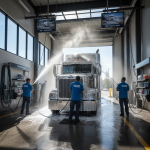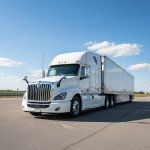If you own or operate a truck wash facility, it’s important to take steps to minimize the potential for environmental problems. By implementing effective strategies, you can reduce the impact on the environment and ensure that your operations are sustainable. In this guide, we will provide you with valuable tips and techniques to help you reduce potential environmental problems at your truck wash facility. Start implementing these strategies today and make a positive difference for the environment.
Implement Water Conservation Measures.
One of the most effective ways to minimize environmental impact at a truck wash facility is to implement water conservation measures. Truck washes typically use a large amount of water, so finding ways to reduce water usage can have a significant impact. Consider installing water-saving equipment such as low-flow nozzles and high-pressure sprayers to minimize water waste. Additionally, you can implement a water recycling system to reuse water for multiple washes. By conserving water, you can reduce your facility’s water consumption and contribute to a more sustainable operation.
Use Environmentally Friendly Cleaning Products.
Another important step in minimizing environmental impact at a truck wash facility is to use environmentally friendly cleaning products. Traditional cleaning products often contain harsh chemicals that can be harmful to the environment and human health. Look for cleaning products that are labeled as biodegradable, non-toxic, and phosphate-free. These products are designed to break down safely in the environment and minimize pollution. By using environmentally friendly cleaning products, you can ensure that your truck wash facility is operating in a more sustainable and responsible manner.
Properly Dispose of Waste Water and Chemicals.
Properly disposing of waste water and chemicals is crucial for minimizing environmental impact at a truck wash facility. Improper disposal can lead to contamination of water sources and harm to ecosystems. To ensure proper disposal, it is important to follow local regulations and guidelines. This may involve using designated disposal areas or working with licensed waste management companies. Additionally, consider implementing water treatment systems to remove pollutants from waste water before it is discharged. By taking these steps, you can effectively minimize the environmental impact of your truck wash facility.
Install and Maintain Oil/Water Separators.
One effective strategy for minimizing environmental impact at a truck wash facility is to install and maintain oil/water separators. These devices are designed to separate oil and other contaminants from water, preventing them from being discharged into the environment. Oil/water separators work by allowing water to flow through while capturing and containing the oil, which can then be properly disposed of. Regular maintenance of these separators is crucial to ensure they are functioning properly and effectively removing contaminants. By implementing and maintaining oil/water separators, you can significantly reduce the environmental impact of your truck wash facility.
Educate and Train Staff on Environmental Best Practices.
In order to minimize environmental impact at your truck wash facility, it is essential to educate and train your staff on environmental best practices. This includes providing them with the knowledge and skills necessary to properly handle and dispose of hazardous materials, as well as implementing procedures for waste management and recycling. By ensuring that your staff is well-informed and trained on environmental best practices, you can ensure that they are taking the necessary steps to minimize the impact of your truck wash facility on the environment. Additionally, ongoing training and education can help to keep your staff up-to-date on the latest regulations and guidelines, allowing you to stay in compliance with environmental laws and regulations.
How to Reduce the Potential for Environmental Problems at a Truck Wash
Truck and heavy equipment washing is usually performed in one of three ways:
- On-site mobile washing – vehicles are washed by facility owners or a commercial wash service that comes on-site with portable equipment such as high pressure hot water (including steam) hoses or wands, brush cleaners, dry washing with aerosols, and self-propelled washing units.
- On-site permanent wash facilities – vehicles are washed at a fixed system in a building or outside. Permanent facilities include drive-through brush systems and multi-step pressure wash bays.
- Off-site commercial washing – trucks may be driven to wash facilities operated by a commercial company other than the company that owns the trucks being washed. The facilities operate similar to permanent wash facilities.
With methods 1 and 2, the transportation facility is responsible for complying with wastewater discharge/disposal regulations. With method 3, the burden of wastewater discharge/disposal compliance is with the off-site commercial washing operation.
Vehicle washing can create a significant volume of wastewater, which is regulated in one of several different ways, depending on how it is disposed.
There are seven primary options for disposing of wastewater vehicle washing:
- Haul it to a treatment facility.
- Discharge it to a municipal sanitary sewer system (also known as a Publicly Owned Treatment Works or POTW).
- Discharge in accordance with an NPDES permit.
- Evaporate it.
- Allow it to percolate into the ground.
- Discharge to a septic system, well drain field, cesspool or similar disposal feature.
- Utilize a water recycling system
The most common form of non-compliance is to discharge the vehicle wash wastewater into a storm sewer system or into a city street that drains to a storm water inlet. Most storm drainage systems discharge directly to streams or other water bodies without treatment, which means anything that discharges into a storm drain is the same as putting it directly into the stream.
Each of the seven options is discussed below.
Option 1 – Hauling
Option 1 is an economical solution when there is a sufficiently small volume of wastewater generated, for example where extensive on-site recycling is employed and only a small concentrated volume of wastewater is generated. Before you haul wastewater you must perform a hazardous waste determination. This may involve getting it tested by a laboratory. If the wastewater is “hazardous” you must manage, transport and dispose of it using special procedures. For more information, see the TERC Hazardous Waste section. If the wastewater is non-hazardous, then you should maintain test records that support your determination.
Option 2 – Discharge to a POTW
Discharging to a Publicly Owned Treatment Works is referred to as an “indirect discharge,” because your wastewater is going to a POTW before it is subsequently discharged to a stream or other water body. This is viable when the transportation facility is located in an area served by a municipal sanitary sewer system. Before you initiate option 2 you must acquire a permit or written notification from either your local sewer district or state environmental agency. You will also have to meet certain rules found in federal and state regulations, including:
- You are prohibited from discharging any pollutant, including oil, that may upset or interfere with the sewage treatment processes or pass through the system untreated.
- You cannot discharge pollutants (e.g., solvents) that may cause a fire in the sewer system.
- You cannot discharge pollutants such as sludge (e.g., grease, dirt) that may clog the sewer system.
To meet sewer discharge standards, you may need to install equipment such as an oil/water separator to prevent oil and sludge from being discharged to the sewer. This is referred to as “pretreatment.” The oil and sludge collected by pretreatment equipment will have to be periodically removed and disposed of, possibly as a hazardous waste (you must make a hazardous waste determination). Other types of treatment that are commonly employed with vehicle washing wastewater include pH adjustment and settling processes. For more information see Pretreatment Standards and Limits.
Option 3 – Discharge to a Stream
Discharging to a stream or other water source including ditches or culverts that lead to streams are termed “direct discharge.” This is a potential option for vehicle washing wastewater disposal, but one that requires a National Pollutant Discharge Elimination System (NPDES) permit or state equivalent. In some states, a “general NPDES permit” for vehicle washing (see example general permit) may be obtained and in other states, you will need to apply for an individual permit. If you obtain this type of permit, you may be required to meet discharge standards (usually more stringent than indirect discharge standards) and demonstrate that you are in compliance by collecting samples of your wastewater and having them analyzed at a laboratory. You may also have reporting and recordkeeping responsibilities. For more information see NPDES.
Persons responsible for new wastewater discharges requiring a NPDES permit for vehicle washing are required to apply for an individual permit or seek coverage under a general permit at least 180 days before discharge of vehicle wash wastewater is scheduled to begin.
Option 4 – Evaporation
With this option, a facility constructs a berm on an impervious surface to capture vehicle wash wastewater and hold for a sufficiently long time period that it evaporates. Obviously, this option is only viable for small vehicle washing operations in dry climates. With this option, if your vehicle wash wastewater does not reach a stream or ditch/culvert that leads to a stream or other water body, then there are no permitting requirements under the federal Clean Water Act.
Note that state or local regulations may preclude the use of this option, so check with your state environmental agency and local government before implementation.
Option 5 – Discharge to the Ground
NPDES permit requirements may be avoided and impacts on local streams minimized if vehicles are washed without the use of chemicals in a vegetated or grassy area where the wash water will percolate into the ground instead of allowing it to run into the street and then into a storm drain. This option is usually limited to very small operations. Also, there may be additional requirements if chemicals (detergents, waxes, etc.) are used or if the absorbed water will reach an underground water body.
Note that state or local regulations may preclude the use of this option, so check with your state environmental agency and local government before implementation.
Option 6 – Discharge to a Septic Tank
Discharging vehicle washing wastewater to a septic tank is a viable option as long as the septic tank is not being used as a “motor vehicle waste disposal well,” it is designed to handle the volume and characteristics of the vehicle washing wastewater, and no state or local regulations preclude its use for this purpose. Further, there must be no significant potential for discharge of industrial, hazardous or toxic liquids and the wastewater must have constituents similar in concentration to domestic wastewater (including animal or vegetable matter, soap solutions, and diluted domestic-use cleaning solutions).
If a septic tank is to be used for wash water disposal, then engine, undercarriage, and transmission washing is prohibited. [Wash water from engine, undercarriage and transmission washing and from the cleaning of the interior of truck trailers and other large commodity-carrying containers must be collected and discharged to a municipal sewer system, treated in a closed-loop, wash water recycling system or some other acceptable method.] Also, vehicle washing operations should minimize the detachment of paint residues, heavy metals, or other potentially hazardous materials from vehicle surfaces. The use of acids, bases, metal brighteners, degreasing agents or steam is also prohibited. EPA recommends the use of non-toxic, phosphate-free cleaners with cold water as cleaning agent.
Note that state or local regulations may preclude the use of this option, check with your state environmental agency and local government before implementation.
Option 7 – Utilize a Water Recycling System
This option involves the purchase of treatment equipment that is capable of removing a sufficient percentage of contaminants from wash water so that it can be recycled over and over. Wash water recycling systems can be owned and operated on-site by transportation companies, contractor-owned and operated at the fleet owner’s site or airport using mobile units, or stationary systems located at the contractor’s facility. Commercial units are available as systems that include spray washing, water collection, pumping/piping, and treatment equipment. Treatment typically consists of various filtering and clarification processes to remove solids. Individual components are also available that can be retrofit to existing washing operations. The systems generate a sludge or concentrated wastewater that must be disposed of. A hazardous waste determination must be made before disposal. Water recycling is generally more expensive than once-through water use, due to high equipment costs. However, it is especially applicable to situations where water use is limited or controlled due to droughts and/or where discharge options (e.g., POTW) are unavailable.

Consider all of the issues described in this guidance when designing a new car wash. An existing car wash may need improvements in order to prevent environmental problems. Certain operating techniques may also help reduce your impact on the environment. These techniques are called “best management practices,” the most effective and practical methods of preventing pollution generated by a particular type of activity. For a clean car wash, adopt the following best management practices. • Perform regular maintenance on all parts of your system. For example, a clogged drain may cause overflows and runoff. • Handle, store, and dispose of grit-trap waste in a manner that will avoid spills or releases and prevent it from causing a nuisance such as odor.
• Cover wash bays to prevent stormwater from entering the drain.
• Inspect equipment, tanks, containers, and nozzles regularly for leaks or clogs. Make repairs immediately.
• Recycle and reuse wash water.
• Install low-flow nozzles or adjust flow in nozzles, sprays, and other lines to meet minimum quality requirements. Calibrate equipment regularly.
• Replace worn equipment with water-saving models.
• Replace brass or plastic nozzles with more durable stainless-steel or hard ceramic nozzles. • Install positive shut-off valves.
• Wash towels and rags in high-efficiency washing machines and run fewer and fuller loads.
• Use biodegradable products instead of solvent-based or highly concentrated solutions.
• Reduce the amount of detergent you use in your system. Less detergent produces fewer suds and reduces the amount of rinse water needed.
• Water softeners and special filtration units can lower the amount of solids in the water and reduce spotting.
• Store fuel in an aboveground, instead of an underground, tank.




